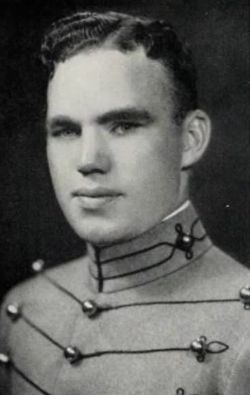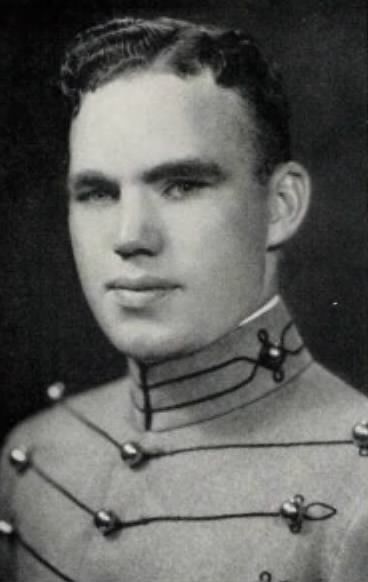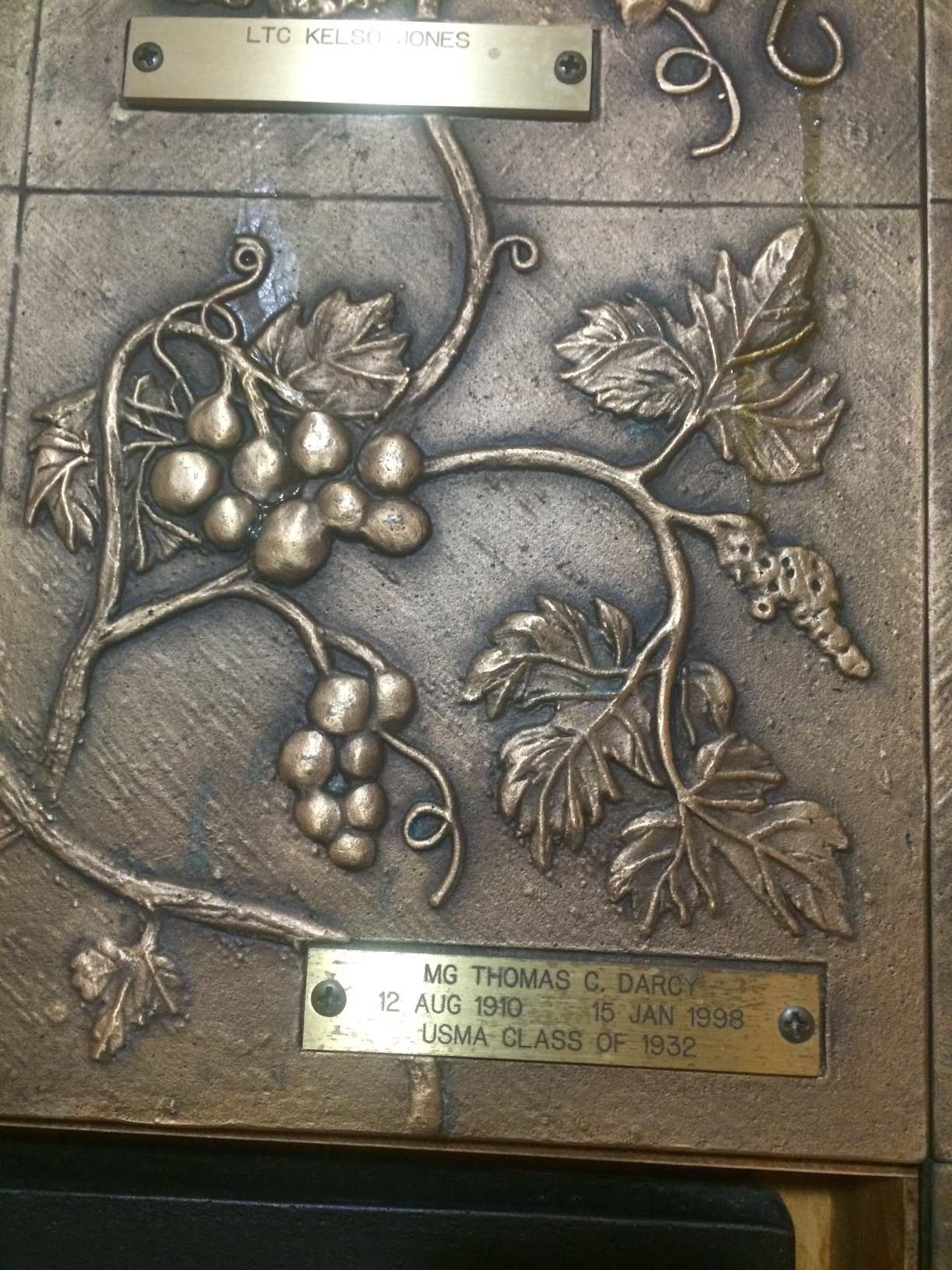Major General.
He was the son of Thomas Lawrence Darcy (born 1879 in Ireland) and Delia T. Connell Darcy (about 1881-1953).
Thomas Connell Darcy was born in Boston, Massachusetts, in 1910. He was a graduate of the Boston Latin School. In 1932 when he graduated from the United States Military Academy, he was assigned to the Army Air Corps Flying Training Command in Randolph Field, Texas where he earned his silver wings. He was then assigned to the 8th Pursuit Group at Langley Field, Virginia. He then returned to Randolph Field as an instructor. Next, he was assigned to Albrook Field in Panama for four years where he flew Boeing P-12s and was the aide to General Frank Andrews. Then the Japanese attacked Pearl Harbor. From Panama, he was ordered to Cairo, Egypt, where he served with the Desert Air Force (DAF) as Chief of United States Forces. He remained with the DAF through Libya and Tunisia. He then joined the 12th Air Support Command and served through the air phases of Salerno, Naples, Monte Cassino, Elba and southern France. For his service and bravery, he received honors from six European and South American nations, as well as the Distinguished Service Medal from the United States. He was promoted to brigadier general, becoming, at age 31, one of the youngest officers to reach that rank. He returned to Italy and advanced with the 87th Fighter Wing against German units, as well as flying escort for two United States bomber groups of B-25s and B-26s. His fighters primarily supported United States ground forces against the Island of Elba. His unit was substantial as it was combined with the French and British units, including more than 1,200 fighter aircraft. On August 15, 1944, he returned to Italy, landing with the Fifth Army and heading the 27th Tactical Air Command. He led the advance across the River Po to the base of the Alps, which became his final headquarters, as the war against Germany and Italy terminated in May 1945. He was ordered to Caserta, as Director of Operations for the Trieste Problem, for a short period before his transfer to Paris in late May as Director of Operations for the United States Air Force in Europe. From Paris, he moved to Wiesbaden, Germany, along with Headquarters, USAAF, Europe. In April 1946, he was sent back to the United States to the Joint Headquarters, USAAF Training Command, at Barksdale Field as Director of Operations. Then, in January 1948, he reported to Williams Field in Arizona as Commander of the USAA Flying School where props were replaced by jet turbines. In 1949, he was ordered back to Germany as Special Assistant for the establishment of the Berlin Airlift. In June of that year, as Chief, he organized and brought into being the 2d Air Division at Landsberg, Bavaria. His command included all USAF fighters in Europe, two fighter wings and the radar units in Germany. His mission was to warn against Russian attack in what became the Cold War. In 1952, he was ordered back to the United States to command the 31st Air Division, with headquarters at Minneapolis as part of Command Guard against Russian attack from the north. In June 1953, he was promoted to major general and ordered to Copenhagen, Denmark, as Chief of the United States Military Assistance Group. In June 1957, he returned to the United States as Chief of the Western Hemisphere Affairs Office in the Pentagon. His final assignment involved duty with the Inter-American Defense Board, United States-Brazilian Defense Committee and the Mexican-American Defense Committee. On December 31, 1961, he retired from active duty. After retirement, he returned to Holland, where he had his boat, Cavu built. He sailed the Mediterranean and European waters for a year. Returning to the United States, he married Marjorie Radcliffe and settled in Florida. They later moved to Essex, Connecticut where he died in January 1998 at the Essex Meadows Health Center in Essex. He was survived by his wife, Marjorie, of Harbor View Drive South in Essex. Mass was celebrated at Our Lady of Sorrows Church on Prospect Street in Essex. Burial was in West Point. Remembrances were suggested to the Association of Graduates. Arrangements were by the Robinson, Wright and Weymer Funeral Home in Centerbrook.
Sources: United States Military Academy Association of Graduates memorial and The Hartford Courant, Friday, January 16, 1998.
Major General.
He was the son of Thomas Lawrence Darcy (born 1879 in Ireland) and Delia T. Connell Darcy (about 1881-1953).
Thomas Connell Darcy was born in Boston, Massachusetts, in 1910. He was a graduate of the Boston Latin School. In 1932 when he graduated from the United States Military Academy, he was assigned to the Army Air Corps Flying Training Command in Randolph Field, Texas where he earned his silver wings. He was then assigned to the 8th Pursuit Group at Langley Field, Virginia. He then returned to Randolph Field as an instructor. Next, he was assigned to Albrook Field in Panama for four years where he flew Boeing P-12s and was the aide to General Frank Andrews. Then the Japanese attacked Pearl Harbor. From Panama, he was ordered to Cairo, Egypt, where he served with the Desert Air Force (DAF) as Chief of United States Forces. He remained with the DAF through Libya and Tunisia. He then joined the 12th Air Support Command and served through the air phases of Salerno, Naples, Monte Cassino, Elba and southern France. For his service and bravery, he received honors from six European and South American nations, as well as the Distinguished Service Medal from the United States. He was promoted to brigadier general, becoming, at age 31, one of the youngest officers to reach that rank. He returned to Italy and advanced with the 87th Fighter Wing against German units, as well as flying escort for two United States bomber groups of B-25s and B-26s. His fighters primarily supported United States ground forces against the Island of Elba. His unit was substantial as it was combined with the French and British units, including more than 1,200 fighter aircraft. On August 15, 1944, he returned to Italy, landing with the Fifth Army and heading the 27th Tactical Air Command. He led the advance across the River Po to the base of the Alps, which became his final headquarters, as the war against Germany and Italy terminated in May 1945. He was ordered to Caserta, as Director of Operations for the Trieste Problem, for a short period before his transfer to Paris in late May as Director of Operations for the United States Air Force in Europe. From Paris, he moved to Wiesbaden, Germany, along with Headquarters, USAAF, Europe. In April 1946, he was sent back to the United States to the Joint Headquarters, USAAF Training Command, at Barksdale Field as Director of Operations. Then, in January 1948, he reported to Williams Field in Arizona as Commander of the USAA Flying School where props were replaced by jet turbines. In 1949, he was ordered back to Germany as Special Assistant for the establishment of the Berlin Airlift. In June of that year, as Chief, he organized and brought into being the 2d Air Division at Landsberg, Bavaria. His command included all USAF fighters in Europe, two fighter wings and the radar units in Germany. His mission was to warn against Russian attack in what became the Cold War. In 1952, he was ordered back to the United States to command the 31st Air Division, with headquarters at Minneapolis as part of Command Guard against Russian attack from the north. In June 1953, he was promoted to major general and ordered to Copenhagen, Denmark, as Chief of the United States Military Assistance Group. In June 1957, he returned to the United States as Chief of the Western Hemisphere Affairs Office in the Pentagon. His final assignment involved duty with the Inter-American Defense Board, United States-Brazilian Defense Committee and the Mexican-American Defense Committee. On December 31, 1961, he retired from active duty. After retirement, he returned to Holland, where he had his boat, Cavu built. He sailed the Mediterranean and European waters for a year. Returning to the United States, he married Marjorie Radcliffe and settled in Florida. They later moved to Essex, Connecticut where he died in January 1998 at the Essex Meadows Health Center in Essex. He was survived by his wife, Marjorie, of Harbor View Drive South in Essex. Mass was celebrated at Our Lady of Sorrows Church on Prospect Street in Essex. Burial was in West Point. Remembrances were suggested to the Association of Graduates. Arrangements were by the Robinson, Wright and Weymer Funeral Home in Centerbrook.
Sources: United States Military Academy Association of Graduates memorial and The Hartford Courant, Friday, January 16, 1998.
Family Members
Sponsored by Ancestry
Advertisement
Advertisement








